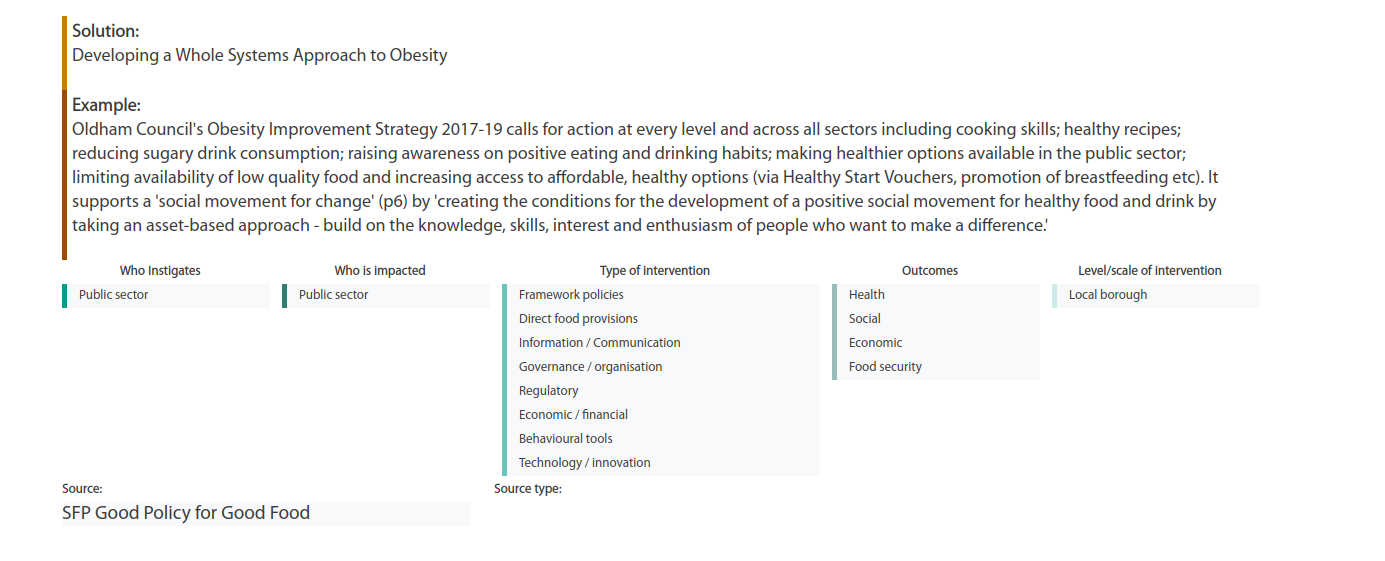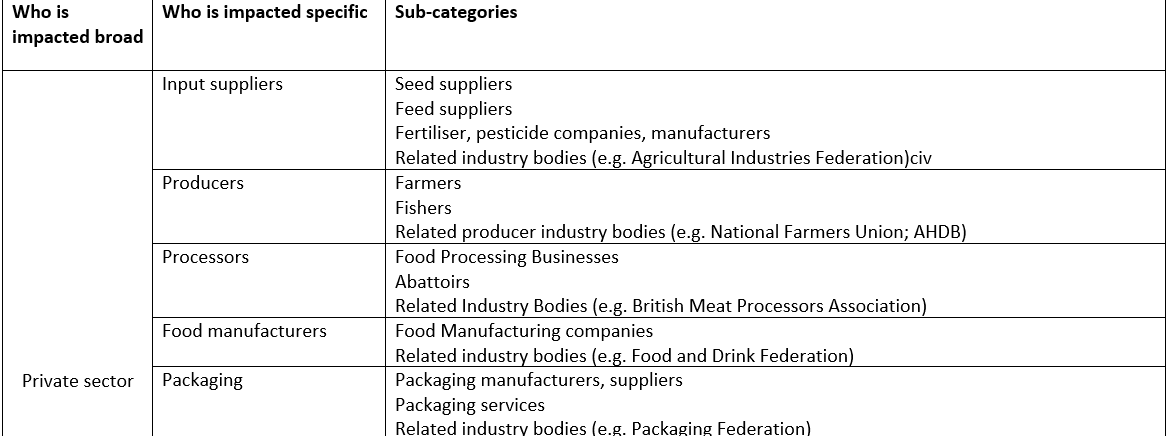This tool can be used to identify solutions which have been used, or been proposed, to change food systems.
There are different ways you can search the database:
Do a broad search by entering a term in the box. Your results will feature all solutions which use this term in their title or description.
You can use the category filters to refine your search by ticking boxes if you are interested in particular actors, outcomes or levels.
What your results will look like:
The database is underpinned by an Excel spreadsheet, in which each solution is listed alongside the source where it came from. Each solution is then “tagged” according to each of five categories, each of which have between four and nine options. A solution can be tagged as being relevant to one, some or all of these options, but must be tagged for at least one option in each of the five categories (i.e. the options within each category have exhaustive definitions). When you search by category option on the website, the database will return for you all solutions which have been tagged as being relevant to all of the category options you have selected, therefore the more you select, the fewer solutions will be returned.
Each result will display the following information about a solution:

Your Food system TSB search results can be viewed through the web interface, or downloaded as an excel spreadsheet. Click the 'Results as CSV file' button to download as a csv file.
Monitoring the use of the Food System TSB will help us to make the case for further funding to develop the tool. Please complete the very short form to tell us who you are and why you are interested in food system solutions. Your data will only be used to inform the development of the tool.
The Food System TSB solutions are tagged by five main categories, related to who instigates the solution, who is impacted by or delivers it, which type of intervention or lever is used, which food system outcomes are impacted, and which level or scale of action is relevant. The categories are explained briefly below and in further detail in the accompanying Food System Solution Taxonomy document. These categories were identified as the most important for tagging solutions in this initial iteration of the tool. Further categories will be added as the Food System TSB evolves and expands. Details of how the categories were chosen, and which categories are recognised as important but not yet tagged, can be found in the project report.
Which type of food system actor will initiate this solution? They are broken down broadly into three – public sector (government), private sector (food businesses), and third sector (charity, community). The instigator may or may not be the same actor who is impacted. For example, a public sector government might issue (instigate) a regulation banning junk food advertising in place (which is then implemented by - and thus impacts - private sector food/media companies). Or a private sector food company might put in place a price promotion (which is implemented by itself, but also directly impacts consumers in its store).
As above, this refers to which food system actors will be impacted by the solution, either by having to deliver/implement it (in the case of a manufacturer needing to reformulate its products in response to a government-instigated standard), or being directly affected by it, such as if an action directly targets consumer behaviour.
Outcomes refer to the impacts which the solution is targeting. These can be divided into Intended outcomes, which are those which were part of the original design of the solution, and unintended outcomes, which are either secondary impacts, or impacts which were not expected. For example, a solution to increase fruit and vegetable consumption may be doing so to improve health, but it may also have secondary environmental benefits if the fruit and vegetables replaces meat in the diet, and may have unintended consequences for producers - if they get more orders for fruit and vegetables, or fewer orders for meat, as a result.
This refers to the type of policy, measure, action which the solution represents. It consists of predominantly policy measures, or other types of intervention, with a clear delivery mechanism such as ‘information and communication’ or ‘fiscal’. There is an additional category of ‘practical actions’, which is used for solutions which are more about ‘doing’ practical things, without any formal policy or intervention mechanism involved.
This refers to the level of governance/scale at which the solution is operating. It might be national law, or a national supermarket campaign, a regional funding pot, a city-wide campaign, a local borough initiative, a neighbourhood project, or a single hospital programme.
Further details on the categories in the TSB, including more granular detail on how actors, interventions, outcomes and levels are categorised, can be found in the accompanying ‘Food System Solution Taxonomy’.
